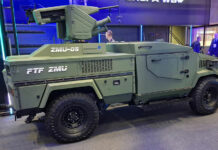AUSA, Washington DC, October 2009: As the largest world operator of UAVs, the U.S. Army has flown over 760,000 combat flight hours with the growing fleet of UAVs. To date, over 1,400 UAS operators have been trained with 2,300 additional trainees competing their training in 2010. Among the new UAVs, the Army is taking delivery of the first Sky-Warrior Extended Range Multi-Purpose UAV among 11 systems (132 aircraft) planned for procurement, the first platform designed from Intelligence, Surveillance, Reconnaissance and Attack missions. Similar missions are being performed by the MQ-5B Hunter, while improvements underway for the RQ-7 Shadow small UAV will introduce closer cooperation with ground units, directly linking UAVs with scout and attack helicopters, via the new VUIT-2 system.
Enhancements are also performed with the RQ-11B Raven, deployed with a new digital datalink, thus increasing the number of Ravens operating simultaneously in an area from 4 to 16. A new addition is the new XM-156 T-Hawk UAV is planned to be deployed with all 73 brigade combat teams in the upcoming years. More supporting systems enhancing the use of unmanned systems are also being fielded – including common ground stations and controllers, and command, control and remote video terminals, enabling more users to take advantage of these indispensable assets.
Ongoing programs are underway to upgrade and increase the number of helicopters in the fleet, introducing models of UH-60M Black hawk and CH-47F Chinook built as new or re-manufactured from existing platforms. The Army is also fielding a new aviation brigade to be equipped with available assets. To sustain the new and existing units pressed hard under the deployment cycles and combat tempo, extensive pilot training is underway at Ft. Rucker, to fill the gaps in trained aviators and support personnel. Other programs are moving slowly or stalled altogether. These include in-theater transport, joint heavy lift helicopters, and aerial common sensor (ACS) SIGINT system. Instead, the Army promoted ad-hoc systems developed to meet urgent combat requirements, such as the Aerial Counter-IED ODIN Task Force, Project Liberty and Constant Hawk platforms – all developed, maintained and operated in theater by civilian contractor L3 Communications.
















